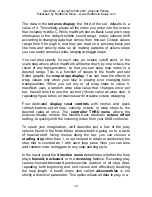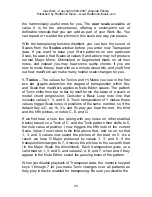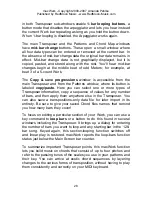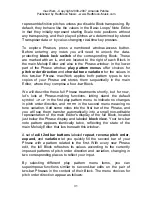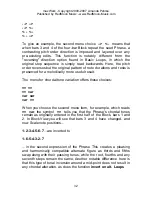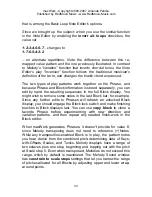
maxWerk - Copyright 2000-2007 Amanda Pehlke
Published by RedMoon Music - www.RedMoon-Music.com
23
apply it to filter cutoff, resonance or pitch bend. If you use the
latching checkbox, there is no need to enter a starting pattern
because maxWerk creates a new one at the start of each loop. The
window's step mode indicator changes to read rdm, but since these
patterns are not editable, the changing sets of values don't appear
in the display. Part II describes in detail these and more features of
the Control A, Control B, and Bend Editors.
1.9 The Transposer
The Transposer contains maxWerk's pitch-filtering system. Your
Werk can change Key and Scale automatically as it makes modal
chord changes within both Key and Scale. As a fun bonus, while
maxWerk is in play and the Transposer is enabled and making
chordal transformations to stored patterns, your keyboard re-maps
itself according to Key and Scale as you play, so that all you have to
do to competently noodle a live line over tracks is repeat simple
patterns emotively on the white keys in C.
The Transposer has bar-graph displays of four different sets of data
for 128 bars. The values that you see in the primary window of the
Transposer appear again in the smaller displays of the Patterns
window, which is accessible via one of the secondary-window
buttons along the bottom edge of the Transposer. The Patterns
window reflects the state of any 16 bars of Werk that you wish to
bring into focus. Whenever it is opened, and whenever you use the
bar scrolling function with buttons or key commands, the current bar
becomes the first shown in the Patterns display.
A more fundamental form of transposition underlying these, for
which there is no graphic display, comes from the Global Offset
Map, accessed by a button at the top of the main Transposer
window. Here you can shift the root pitch of your Werk and your
MIDI controller's input up or down by semitones up to a full octave
from the default C (key signature 3). You can use it to create
overall shifts in the mood of your piece when all is said and done by
making further offsets at any bar. The offset flag appears in the
form of a semitone number following the Key display on the Main
Screen. Global Offsets work behind the scenes, along with all the










